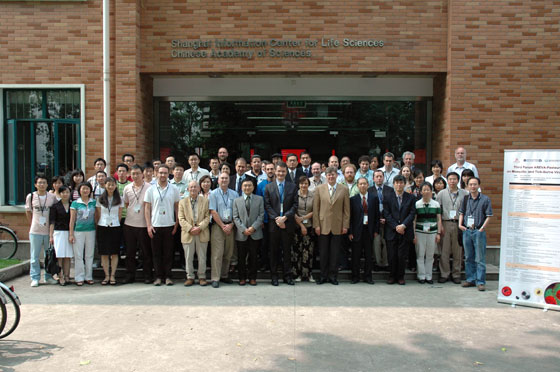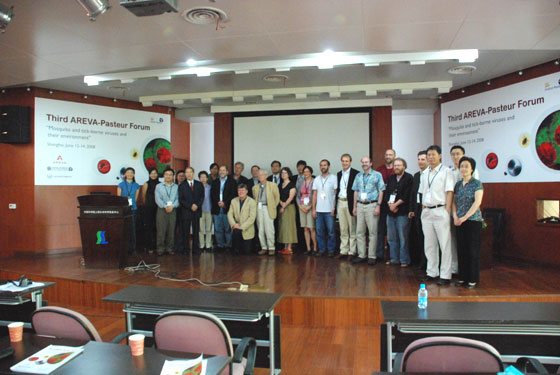The third AREVA-Pasteur Forum on “Mosquito- and tick-borne viruses and their environment” was held in Shanghai in June 12-14, 200 8. The forum was co-organized by AREVA, Institut Pasteur of Shanghai and Wuhan Institute of Virology, both from the Chinese Academy of Sciences. Prof. Chen Xiaoya, President of Shanghai Institutes for Biological Sciences, CAS, Mr. Marc de Andolenko, President of AREVA in China delivered their warm addresses to the opening of the Forum. 26 scientists from China, Japan, Southest Asia, Europe, Australia and United States were invited to present their excited progress in research. About 80 scientists from China and abroad attended the meeting. The tenue of the meeting was of the highest international standards and the audience has appreciated the updated information provided by the experts in the field.
In particular, the following data were presented and warmly discussed:
In particular, the following data were presented and warmly discussed:
- Arboviruses are changing concomitantly to the evolution of the world, but remain in wild animals and vectors. Old and newly discovered arboviruses are important threats in China and southeast Asia. Crimean Congo hemorrhagic fever represent a serious disease in Northwest of China.
- Arboviruses circulate in complex cycles involving several vectors at once and have the capacity to be transferred from one arthropod to the other co-feeding their blood meal on the same host recipient. Saliva of the arthropod may be an important factor in virus transmission and innate immunity modulation.
- Different forms of flavivirus structures were extensively studied using cryomicroscopy, containing cleaved or uncleaved prM (precursor of M). The flavivirus lipidic envelope shell swells when exposed at different pH environments. The structure of the flavivirus capsid protein as been resolved but the whole virion nucleocapsid structure remains unresolved.
- The structure of the flavivirus envelope protein has been extensively analyzed, a large panel of monoclonal antibodies have been prepared that were used for epitope mapping. The mechanisms of fusion process and amino acid residues involved in the stability of the dimeric form of the envelop proteins at acidic pH were studied.
- The RNA structure and transcription of flaviviruses was decorticated, and O-methylation of the cap structure was recently discovered.
- A small fraction of the 3’-terminus of flaviviral RNA was recently observed and its role in virus escape to host response is now addressed.
- Genetic susceptibility of humans to flaviviruses and also to alphaviruses seems to be associated with IFN-pathway-related OAS gene. The role of DC-sign seems also critical in uptake of dengue virus and hemorrhagic fever.
- Activation of immune response in flavivirus infection involved CXCL10 released by infected dendritic cells to attract T cells.
- Different mouse strains infected with West Nile virus showed differences in lymphocyte counts and timing in antibody response.
- Inflammatory response in the brain of mice infected intranasally with West Nile virus seems to be an important factor of neurovirulence without breakage of the blood brain barrier.
- Flaviviruses interact with GAG residues. This factor may be of importance to clear off viruses in the epithelium and blood stream. It seems that attenuated strains have a higher interaction capacity with GAG and are preferentially cleared of from the infected body.
- INF-depleted mice has been used to increase susceptibility to flaviviruses and to study virus pathogenesis .
- Activation of TLR-3-dependent pathway prevents apoptosis induced by flavivirus infection. Infection of TLR3 knock-out mice seems to increase apoptosis which in turn reduces virus load and pathogenesis.
- Characteristics of the pediatric attenuated Japanese encephalitis vaccine SA14-14-2 prepared on hamster kidney cells were presented, and a new vaccine based on the same strain prepared on Vero cells and inactivated was tested in adults. A scheme of three doses was proposed for this new vaccine. However the cost may restrict its use to travelers.
- Chimeric tetravalent dengue vaccine is on trial in Mexico.
- New drugs targeting the polymerase of flaviviruses are in the pipeline. siRNA is also a promising approach for anti-viral therapy.
This meeting was a useful platform of exchanges and opened a door for collaborations across the world. All attendees are expecting a new Forum in the incoming years. 


